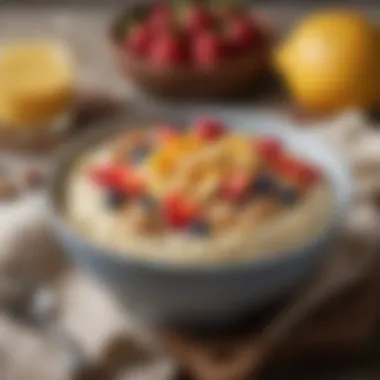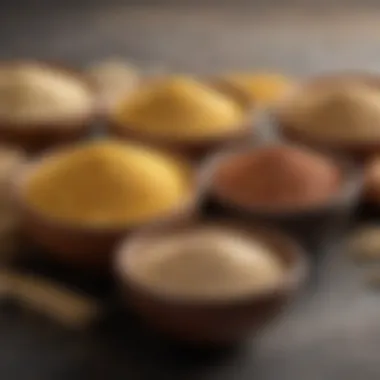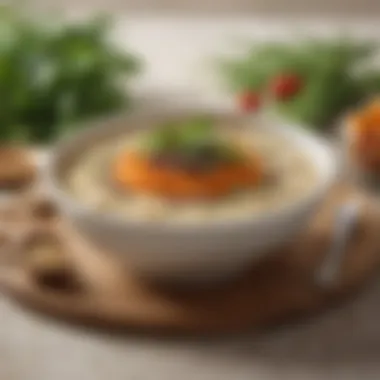Understanding Millet Porridge: Health Benefits & Culinary Uses


Intro
Millet porridge is a dish with deep roots in human history. In recent years, it has found its way back into modern kitchens, gaining popularity due to its numerous health benefits and versatility. This article seeks to explore the intricate world of millet porridge through a focused lens that encompasses its nutritional advantages, preparation techniques, and culinary applications. Our deep dive will ensure that both novice cooks and seasoned chefs are well-equipped to incorporate millet porridge into their culinary repertoire.
Ingredients Breakdown
In any recipe, understanding the ingredients is essential. Replica-ing a good millet porridge requires knowing both the primary ingredients and the optional add-ons that can enhance flavors.
Primary Ingredients
- Millet Grains: The star of the dish, offering a nutty flavor and unique texture.
- Water or Broth: Crucial for cooking the millet to the desired consistency.
- Salt: A pinch of this can delightfully bring out the inherent flavors of millet.
Optional Ingredients
- Sweeteners: Items like honey, maple syrup, or agave nectar can add sweetness, based on personal preference.
- Fruits and Nuts: Chopped nuts, dried fruit, or fresh fruit can give textural contrast and added nutrition.
- Spices: Cinnamon or cardamom can introduce warmth and depth.
Essential Kitchen Tools
- Medium-Sized Pot: To cook the millet efficiently.
- Stirring Spoon: For even cooking. A wooden spoon works well.
- Measuring Cups: To accurately measure millet and liquid.
Step-by-Step Preparation
Preparation is the bedrock of the culinary experience. Understanding each stage can significantly enhance your results.
Prepping the Ingredients
Start by measuring the millet. Rinse it under cold water to remove any debris. This step is often overlooked, but it plays a pivotal role in achieving a clean taste.
Cooking Techniques and Methods
- In a pot, combine one part washed millet and three parts water or broth.
- Bring to a rolling boil on medium heat. A pinch of salt may be added here.
- Reduce heat to low, cover, and simmer for about 15-20 minutes, or until grain is tender and liquid is absorbed.
Assembly and Presentation Tips
Once cooked, fluff the millet with a fork. For serving, place it in a bowl and artistically arrange any added ingredients, such as fruits or nuts on top. This enhances visual appeal and increases its culinary application potential.
Dietary Considerations
Given the rise in awareness of dietary restrictions, it is vital to discuss how millet porridge can serve various nutritional needs.
Gluten-Free Options
Millet itself is naturally gluten-free, making it an excellent option for those with gluten sensitivities.
Vegetarian and Vegan Substitutes
Vegetable broth can be utilized in place of animal-based broth, ensuring that the dish adheres to vegetarian or vegan diets.
Nutrition Facts & Nutritional Considerations
Millet porridge is rich in nutrients, providing high fiber, proteins, and a variety of essential vitamins and minerals. Its low glycemic index makes it a preferred choice for individuals managing blood sugar levels.
Variations and Customizations
One of the prominent features of millet porridge is its adaptability. It can be customized to cater to various tastes and cultures.
Flavor Enhancements
Consider adding flavor-effective ingredients, such as coconut milk for a creamy texture or tangy yogurt to complement sweetness.
Alternative Cooking Methods
Besides boiling, millet can be toasted or cooked using a pressure cooker, enhancing its flavor profile further.
Pairing Suggestions (Sides, Drinks, etc.
) Millet porridge pairs excellently with curries, roasted vegetables, or can serve as a base for a hearty stew.
Common Commonly Asked Questionss and Troubleshooting
In any culinary venture, questions are bound to arise. Below are common inquiries and their solutions.
Frequently Asked Questions
- Why did my millet turn mushy? This is often a result of using too much liquid or overcooking.
- Can I store millet porridge leftovers? Yes. Pour the excess into a tightly sealed container and refrigerate.
Common Mistakes to Avoid
Avoid using high heat during cooking; stick to low flame for the characteristically fluffy texture Millet porridge offers.
Solutions to Potential Problems
For a too-thick porridge, incorporating a little water while reheating can restore its original consistency.
Prolusion to Millet Porridge


Millet porridge holds a significance in both traditional and modern culinary cultures. This dish not only showcases delightful textures and flavors but also offers numerous health benefits that are being rediscovered today.
Millet, an ancient grain, is revered for its nutritional prowess. It stands out in an era where gluten-free diets are prominently spotlighted. Especially for individuals seeking alternatives to wheat, millet offers a wholesome and nutrient-rich option. Exploring millet porridge reveals a world of dietary possibilities, making it valuable for various preferences, including veganism and vegetarianism.
The preparation of millet porridge is simple yet adaptable, accommodating various cooking techniques and preferences. Understanding how to make it, flavor it, and incorporate it into diverse meals can inspire culinary creativity. Additionally, recognizing its connections across cultures position millet porridge as not just food, but as a charming bridge between gastronomy and heritage.
Health-wise, millet porridge serves as a powerhouse of nutrients—such as vitamins, minerals, and fiber. These aspects cannot be overlooked when considering incorporating this grain into diets. Notably, this article emphasizes how millet porridge aids in weight management and heart health, which can resonate with a health-conscious audience seeking long-term wellness.
It’s essential to appreciate the nuances of millet porridge, moving beyond the surface to unveil its broader cultural, nutritional, and culinary significance. Through this exploration, not only cooking enthusiasts but all who are invested in nutritious eating can gain much. In our advancing culinary landscape, millet porridge clearly stands out, deserving careful attention and study.
What is Millet?
Millet is a small, ancient grain gained recognition due to its high nutritional value and versatility in cooking. Understanding millet is critical to appreciating the profound benefits it offers, especially when prepared as porridge. This gluten-free grain provides essential nutrients and fibers, making it a valuable addition to various diets. The different types of millet each bring unique flavors and health benefits, further making millet porridge appealing to food lovers and health-conscious individuals.
Historical Context
Millet has a long and rich history. It is one of the oldest cultivated grains in the world and has been a staple in many cultures. In various regions of Africa and Asia, millet served as a primary food source for thousands of years. Farmers valued millet for its hardiness, adaptability to diverse climatic conditions, and ability to grow in poor soils with minimal water. Myths and traditions surrounding millet highlight its importance and significance across different cultures.
Types of Millet
Understanding the distinct types of millet is essential for choosing the right one for porridge preparation. Each variant has its characteristics, flavors, and nutritional profiles that enhances millet porridge.
Pearl Millet
Pearl Millet stands out due to its high fiber content and nutritious profile. It is often hailed for its ability to thrive in harsh climates. It's a popular choice in many parts of India and Africa.
- Key Characteristics: Pearl millet has a beige or brown color and a chewy texture when cooked.
- Benefits: Its rich magnesium content may contribute to better heart health and reduced risk of diabetes.
- Unique Feature: It retains moisture well, making it suitable for various cooking techniques, particularly boiling.
Foxtail Millet
Foxtail Millet is revered for its rich antioxidant content. It provides numerous health advantages and is also a good source of minerals such as iron and calcium. This form of millet is popular in various Asian countries and is admired for its cooking qualities.
- Key Characteristics: Foxtail millet has small, slender grains that cook quickly.
- Benefits: The presence of polyphenols helps enhance detoxification and overall gut health.
- Unique Feature: It has a light, nutty flavor that makes it an excellent addition to both sweet and savory dishes.
Broomcorn Millet
Broomcorn Millet is less common but provides a unique nutrition profile. It often serves as animal feed in various cultures but holds potential humans as well. It is especially valued in certain traditional dishes.
- Key Characteristics: Broomcorn millet has a coarser texture, making it ideal for specific culinary uses.
- Benefits: It may help in high-energy diets due to its carbohydrate content but is often overlooked.
- Unique Feature: Its rough texture can provide added digestibility advantages in some recipes.
Finger Millet
Finger Millet is an ancient grain celebrated mostly for its high calcium and amino acid profile. This type of millet is popular in both Indian and African cuisines because of its dense nutritional withdrawal.
- Key Characteristics: Finger millet has a reddish-brown color and forms sticky porridge.
- Benefits: It is especially beneficial for bone health, due to the high calcium content.
- Unique Feature: Its ability to encourage satiety makes it ideal in weight-management plans.
Overall, understanding the diverse types of millet enriches the experience of preparing and consuming millet porridge. Each type offers texture, flavor, and health benefits; making them adaptable for various palates and dietary preferences. Incorporating millet into daily meals, particularly in porridge form, endorses both health and savoriness.
Nutritional Profile of Millet
The nutritional profile of millet is fundamental for understanding why this ancient grain has found its place in modern dietary practices. Rich in vitamins, minerals, fiber, and protein, millet serves as an excellent addition to a balanced diet. It not only delivers essential nutrients but also supports various health benefits, making it a pragmatic choice for provision of nutrition.
Vitamins and Minerals
Millet is a good source of several vital vitamins and minerals. It includes B-vitamins such as niacin, riboflavin, and B6, contributing to overall energy metabolism, skin health, and brain function. Furthermore, millet contains several important minerals:
- Magnesium: This mineral is crucial for muscle function and blood sugar control.
- Iron: An essential element for the production of hemoglobin, iron helps prevent anemia.
- Phosphorus: Supports bone health and energy production.
- Zinc: Important for immune function and cellular metabolism.
These nutrients collectively help in maintaining overall wellbeing. Regularly incorporating millet into meals can lead to a notable improvement in daily nutritional intake.
Fiber Content
Millet shines in its fiber content. High fiber diets have numerous health benefits, especially for the digestive system. Fiber helps regulate bowel movements and promotes a feeling of fullness, which can be helpful in weight regulation. Moreover, research shows that high fiber intake can lower the risk of developing chronic diseases. Along with improving digestive health, millet's fiber assists in:
- Lowering cholesterol levels: This is vital for maintaining heart health.
- Managing blood sugar levels: Fiber enhances insulin sensitivity.
- Promoting gut health: Supporting beneficial gut bacteria can contribute to overall gut microbiome balance.
Protein Sources
Millet offers a decent amount of plant-based protein, making it valuable for both vegetarians and vegans. While individual proteins have unique amino acid profiles, millet includes essential amino acids, particularly methionine and cysteine. This can be advantageous to those seeking to enhance their protein sources in vegetarian diets. Following are more benefits of the protein in millet:
- Building block for body tissues: Protein supports repair and growth.
- Supporting metabolic functions: Contributes to energy levels and recovery post-exercise.
- Sustaining energy levels: Higher protein content can help maintain stable blood sugar levels.
Among other whole grains, millet holds a distinguished position due to its unique nutritional portfolio. As we incorporate millet porridge into our meals, we harness the nutritious advantages beneficial for a multitude of health aspects.
Health Benefits of Millet Porridge
Millet porridge has re-emerged in our food culture, offering numerous health benefits that merit attention. While we often seek out familiar grains, millet stands out due to its distinct nutritional profile. Understanding these health benefits is crucial, as incorporating millet porridge can enhance dietary choices and contribute to overall well-being. In this section, we'll explore important aspects such as gluten-free attributes, support for weight management, and heart health considerations.
Gluten-Free Alternative
For those with gluten intolerance or celiac disease, millet porridge serves as an excellent gluten-free grain. This faact is significant because many common starches contain gluten, making it challenging to find appropriate substitutes. Millet is free from gluten, meaning its consumption does not provoke adverse reactions for individuals with these conditions.
A diet focused on gluten-free foods is often marked by limitations in terms of nutrients. However, millet provides essential vitamins and minerals that may be lacking in an overly restrictive diet. Research suggests that switching to gluten-free grains such as millet does not need imply compromising the variety وتعابي الثقافة on your plate. Instead, millet can add]ii richness and depth to meals while ensuring they meet dietary requirements.
Weight Management


When managing body weight, choosing nutrient-dense foods plays a vital role. Millet porridge qualifies as an apt candidate due to its high fiber content. Fiber contributes to feelings of fullness, potentially reducing overall caloric intake when included in meals. Moreover, slow-digesting carbohydrates are found in millet, releasing energy gradually and preventing spikes fade iu blood sugar
Incorporating millet into one’s diet presents flexibility as well. It can be used in various recipes, serving as porridge or as an ingredient in lighter dishes. This adaptability encourages healthier eating habits and enhances meal diversity, which can assist long-term weight control goals.
Heart Health
Another poignant benefit of millet porridge is its positive impact on heart health. The consumption of millet can lower the risk of chronic conditions such as cardiovascular disease. This is attributed to several components, including magnesium and potassium, both critical in supporting healthy blood pressure levels.
The rich content of antioxidants in millet varies depending on the type. Nihilumism composed of polyphenols is keys oodel for fighting inflammation and reducing cholesterol. In turn, this can help steer one away from heart-related ailments. A heart-healthy diet matters; incorporating millet porridge as a staple food can be a decisive stratigy in promoting overall cardiovascular wellness.
Millet porridge not only fills the stomach, but also nourishes the body. Its benefits transcend mere satiety, empowering a holistic approach toward health.
In summary, millet porridge serves as a nutritious alternative to many conventional grains. Its gluten-free nature makes it a safe option for those with gluten sensitivities, while its fiber supports weight conversations. Finally, its components promote heart health, underscoring millet's role in crafting a balanced diet. Understanding these health benefits could aid in making more informed dietary choices.
Preparing Millet Porridge
Preparing millet porridge is crucial in understanding both its health benefites and culinary applications. Knowing how to prepare it affects the overall consistency, flavor, and nutritional profile. Proper preparation enhances the digestive benefits of millet while making it a tasty dish. This section will guide you through all important steps for successful millet porridge.
Selecting the Right Millet
When it comes to selecting millet for porridge, it is essential to consider the specific type of millet you wish to use. Each variety has its unique flavor and texture. Pearl millet is famous for its mild taste, making it versatile for both sweet and savory dishes. Foxtail millet offers a slightly nuttier flavor, while broomcorn millet can cater to those looking for a unique texture. Finger millet is popular for its nutty taste and high nutritional value. Understand your preferences, as this choice dictates the outcome of the porridge.
Soaking and Rinsing
Soaking millet before cooking serves several purposes. First, it enhances digestibility by breaking down some of the compounds that can hinder nutrient absorption. Rinsing is equally important as it removes possible dust and impurities. Soaking can take anywhere from 30 minutes to a few hours. Ensure you rinse the millet thoroughly under running water after soaking, as this not only cleans the grains but also helps remove bitterness that comes from saponins found in the millet outer layer. Benefits here directly link quality ingredient preparation to nutritious outcomes.
Cooking Techniques
Selecting the right cooking technique is critical in achieving the desired texture and flavor in millet porridge. Several methods can be applied based on personal preferences or equipment available.
Boiling Method
The boiling method is a straightforward approach to making millet porridge. In this technique, the millet is combined with water, usually in a 1:3 ratio, and brought to a boil. The key characteristic is simplicity; anyone can execute it without complex equipment. The boiling method is popular because it ensures minimal loss of nutrients. However, care must be taken to avoid overcooking, which can lead to a gummy texture. The unique feature of this method lies in its straightforward execution. Choosing the boiling method suits beginners and those looking for quick preparation.
Stovetop Absorption Method
This technique involves adding little water and allowing the millet to cook slowly on the stovetop. The absorption method allows for better flavor concentration while producing a creamy texture. A common ratio for this method is 1 cup of millet to 1.5 to 2 cups of water. The key characteristic is the gradual absorption of water and flavors, creating a luxurious porridge. However, this method requires monitoring to ensure that it does not stick to the bottom of the pot. Its benefit is the deeper flavor profile yielded. Note that this method may require greater attention during cooking than the boiling method.
Pressure Cooking
Pressure cooking is a high-speed alternative that yields quick results. Using a pressure cooker to prepare millet means shorter cooking time, usually about 10 to 12 minutes. The key defining characteristic of this method is its ability to preserve nutrients excellently while cooking. Pressure cooking also requires less water, typically a ratio of 1 cup millet to 2 cups of water. The unique feature is its speed and efficiency, making it a beneficial choice for busy cooks. The downside may be the initial learning curve if unfamiliar with pressure cookers, but it results in fluffy and well-cooked millet porridge.
Properly preparing millet porridge can elevate it to a delightful dish suitable for any meal.
Understand each method's attributes before deciding which to use. Every preparation step from selection through cooking intimately relates to the product outcome.
Flavoring Millet Porridge
Flavoring millet porridge is an essential aspect of elevating this dish from simplicity to culinary enjoyment. Given its mild taste and versatile texture, millet porridge can absorb various flavors traditionally found in both sweet and savory dishes. Tuning the porridge with different flavors not only enhances the eating experience but also allows for creativity and personalization in preparation.
Sweet Variations
Using Fruits
Using fruits in millet porridge presents an excellent opportunity to incorporate natural sweetness and nutritional value. Fresh, dried, or even frozen fruits can be added to the porridge, offering various flavors ranging from tart to sweet. Seasonal fruits such as berries, bananas, and apples provide vibrant colors and additional fiber.
Fruits are a beneficial choice because they also add vitamins and antioxidants, nourishing the body beyond basic sustenance. However, fruits may alter the dish's texture, which some might find unappealing at times. It is essential to balance fruit types chosen to ensure that flavors work harmoniously.
Adding Sweeteners
Adding sweeteners is another straightforward way to flavor millet porridge to preference. Popular sweetening options include honey, maple syrup, coconut sugar, and agave nectar. Each sweetener has its distinct flavor profile, which can enrich the porridge in different ways.
This is an appealing choice as many sweeteners can amplify not just sweetness but may also provide some unique health benefits. However, the amount of sweetener used should be moderated to keep the overall dish healthy and balanced. Some individuals prefer natural sweeteners due to dietary preferences or health considerations, highlighting the importance of adapting choices to suit the target audience.
Savory Options
Infusing Broths
Infusing broths into millet porridge enables a culinary avenue toward developing depth in flavor. Adventurous cooks can use vegetable or chicken bone broths to replace water or milk during cooking, providing minerals and protein.
Broth adds a rich, savory element to the dish. This approach can transform the porridge into a hearty meal, suitable for any time of day. The challenge lies in selecting a flavor that complements while not overwhelming the grain's inherent characteristics; balancing flavors is imperative.
Adding Spices and Herbs
Adding spices and herbs to millet porridge introduces another layer of flavor. Common spices like cumin, coriander, ginger, or turmeric can offer warming qualities and intriguing taste profiles paired with herbs like cilantro, parsley, or basil.
This method allows versatility in cooking. Herbs and spices can cater to varying palates, enticing people who may not lean towards traditional porridge palatability. Nonetheless, opting for the right spices and ingredients is paramount, as the wrong combination can lead to a confusing profile that distracts from the dish.
Flavoring millet porridge opens an exciting spectrum, from sweetness to savory delights, appealing to many individual tastes and culinary preferences.
Millet Porridge in Different Cuisines
Millet porridge holds a unique position in global culinary practices. Its significance cannot be overstated, as it adapts remarkably to various cultural contexts. This adaptability brings not only taste but also an array of health benefits that enhance its appreciation across the globe. Understanding millet porridge through different culinary lenses offers an inside look at its flexibility and enduring relevance.
Traditional Uses


In many regions, millet porridge is a staple food that forms the backbone of diets. For centuries, it has served communities—particularly in Africa and Asia. Traditionally, millet porridge is made from ground millet grains, which are cooked in water or milk until they reach a creamy texture. In some cultures, it is commonly enjoyed at breakfast, providing essential nourishment to begin the day.
For instance, in India, a version known as bajra khichdi combines millet with dal, a lentil mix, creating a hearty dish full of protein. In parts of Africa, wok millet porridge is often accompanied by a savory sauce or stewed vegetables. These traditional uses underscore millet's functional value as a versatile resource in local cuisines.
One of the major points is the communal aspect of millet consumption. In many cultures, families celebrate events or gatherings with millet-based dishes, strengthening social connections through food.
Modern Interpretations
As dietary trends shift towards whole and ancient grains, cooking with millet porridge has seen a resurgence. Modern interpretations bring renewed creativity and innovation. Today's chefs often highlight the nutty flavor and rustic texture of millet, incorporating new ingredients to unite traditional eats with contemporary trends.
In urban kitchens, millet porridge may be blended with nuts such as almonds or walnuts for added crunch and health benefits. Furthermore, plant-based milk alternatives are frequently incorporated for those seeking dairy-free options. Recipes now also feature spices like cinnamon or turmeric, appealing to a broader audience interested in flavor variety and health.
Today, millet porridge is not only a nod to traditions but also a canvas for experimentation.
Overall, each progression—from traditional to modern—reinforces the utility of millet porridge. Whether enjoyed as a classic dish in rural communities or reimagined as an innovative meal in urban settings, millet porridge demonstrates its rightful place within culinary arts worldwide.
Millet Porridge as a Meal Base
Millet porridge is versatile, making it an excellent base for various meals throughout the day. Its adaptability is one of the key reasons it resonates in both traditional and modern cuisines.
Incorporating millet porridge as a meal base offers several benefits. First, consider its nutritional profile. Millet is rich in vitamins and minerals, and includes essential amino acids as well. It possesses high fiber content, which aids digestion. This makes establishing millet porridge in different meals appealing for health-conscious individuals.
Moreover, millet's mild flavor provides the perfect canvas for a myriad of taste profiles. It can easily absorb the flavors it is paired with, enhancing the overall meal experience. From sweet breakfasts to hearty dinners, millet porridge can seamlessly fit into any meal category.
Breakfast Options
Starting the day with millet porridge can improve energy levels and provide a nourishing start. Here are some common breakfast options:
- Classic Sweet Porridge: Cook millet with water or milk, then stir in honey or maple syrup and toss in fresh fruits like bananas or berries.
- Nutty Variation: Mix in nuts and seeds such as almonds, walnuts, and chia seeds for added texture and protein.
- Spiced Porridge: Adding spices such as cinnamon or nutmeg results in inviting flavors for the morning.
- Savory Scramble: Combine cooked millet with scrambled eggs and veggies for a protein-packed start.
Selecting these breakfasts shows the range millet porridge can offer in taste and nutrition. Experimentation is key, ensuring a dish suited to diverse palates.
Lunch and Dinner Recipes
At lunch or dinner, millet porridge can move from being a breakfast staple to a substantial meal. Options are plentiful yet straightforward:
- Porridge Bowl: Layer millet with cooked vegetables and drizzle with a tahini or lemon dressing. This presents a balanced mix of complex carbohydrates and fiber.
- Millet and Cheese Bake: Combine newly cooked millet with cheese and a selection of herbs for a gratin-style dish.
- Stuffed Peppers: Use millet as a filling for roasted bell peppers alongside meat or beans for added protein.
Utilizing millet as a main or complement in hearty dishes enriches its role in nutritional diets. Each preparation method can bring out different textures and flavors, ensuring that meals remain enjoyable and satisfying.
Dessert Possibilities
Surprisingly, millet porridge applicability extends to desserts as well:
- Millet Pudding: Cook millet in coconut milk and sweetener for a creamy pudding, perhaps topping with mango or coconut flakes.
- Fruit and Millet Cups: Combine millet porridge with yogurt and fresh fruit in small cups to create a layered dessert.
- Baked Millet Fritters: Mix cooked millet with spices and mashed fruits to form fritters, then bake for a crispy treat.
Including millet porridge in dessert recipes showcases that its potential is only limited by creativity. Offering a healthier alternative to traditional desserts aids in broadening the scope of millet’s culinary versatility.
Millet porridge is not just a food choice; it’s a versatile canvas to express one’s culinary creativity throughout the entire day.
By using millet porridge as a meal base, it can enrich various culinary traditions while maintaining nutritious standards. Keep exploring and adapting millet into different meal categories, and you may discover your go-to dish.
Storing and Reheating Millet Porridge
It is essential to consider how to preserve and reheat millet porridge to minimize waste and maintain quality. Proper storing not only helps in saving time on meal preparation, but also retains the flavor and nutritional components of the dish. Understanding the methods of proper storage is important for anyone who enjoys millet porridge as a frequent component of their diet.
Refrigeration Guidelines
Refrigerating millet porridge is one of the most effective ways to keep it fresh for short durations. It's simple—ensure that the porridge has cooled to room temperature. This cooling step stops the condensation that could cause excess moisture in the storage container.
When placing millet porridge in the refrigerator:
- Use airtight containers. This helps to prevent any external odors from being absorbed and keeps the porridge moist.
- Write the date on the container. This allows you to track how long it has been stored.
- Consume within three to five days for optimal taste and safety.
Freezing Techniques
For longer storage, freezing is a practical alternative. Keeping a supply of millet porridge in the freezer can make for convenient meals at a later date. When freezing, consider these steps:
- Divide the porridge into meal-sized portions. This helps in thawing only what you need.
- Use freezer-safe bags or containers. Squeeze out as much air as you can to avoid freezer burn.
- Label the packages with the date. Generally, frozen millet porridge maintains its best quality for up to three months, after which the texture may begin to deteriorate.
Reheating Methods
To enjoy millet porridge after storing or freezing, proper reheating practices need to be followed to reclaim its taste and texture. There are several methods:
- Microwave: Place the porridge in a microwave-safe bowl, add a splash of water or broth to restore moisture, and cover lightly. Heat in intervals of 1 to 2 minutes, stirring in between.
- Stovetop: Transfer porridge to a saucepan. Add a little liquid for moisture, and heat on low, stirring occasionally until warmed through. This method often helps pamper lost flavors.
- Oven: Preheat the oven to a low temperature. Place the porridge in an oven-safe dish, cover with foil, add a tiny amount of liquid, and heat until warm. This method is slower but preserves texture.
Storing and reheating millet porridge efficiently leads to less waste and optimizes flavor, making it a practical choice for many cuisines. Following these guidelines can enhance the experience of this nutritious dish.
End
The conclusion serves as a vital element of this article by reinforcing the numerous advantages of incorporating millet porridge into a daily diet. Throughout, we have examined the rich nutritional profile of millet, including its vitamins, minerals, and unique fiber and protein sources. These aspects highlight why millet porridge is considered a highly beneficial meal, especially for those seeking gluten-free options or looking to improve their overall health.
Additionally, the various preparation techniques provided allow readers to understand how to best utilize millet in their cooking. From selecting the right type of millet to effectively cooking and flavoring it, each step ensures that its versatility matches various dietary preferences. This article has offered insights into millet porridge as not just a simple dish but a foundation that can adapt to countless culinary applications. Because it interweaves seamlessly into breakfast options, savory dishes, and even desserts, its appeal proves expansive.
Consideration of proper storage and reheating capabilities adds a practical aspect, providing guidance for those looking to meal prep or enjoy leftovers without compromising taste or texture. The effort to prepare millet porridge shows its entrenchment in modern cooking streams, thus the knowledge shared can propel individuals to explore and experiment further.
In summary, the information outlined fosters a deeper appreciation for millet porridge's cultural heritage and nutritional value. Milllets, as integral grains, deserve emphasis beyond traditional recognition, positioning millet porridge as a staple for contemporary healthy diets.
"A return to ancient grains like millet is not just a trend, but a step toward sustainable, health-conscious meal choices."
By understanding the health benefits, preparation methods, and diverse applications detailed again in this article, food lovers of all ages now possess the confidence to engage with millet porridge in their culinary pursuits. Therefore, as we lean towards healthier eating habits, millet porridge should certainly find its place on our tables.







